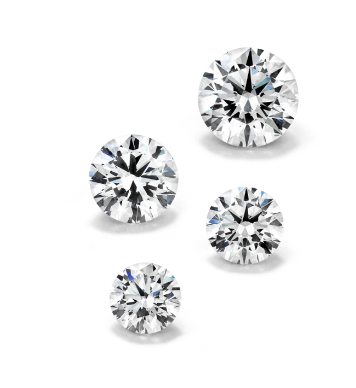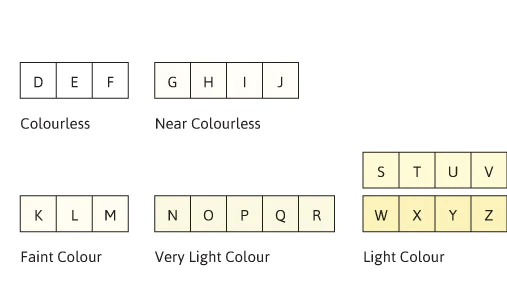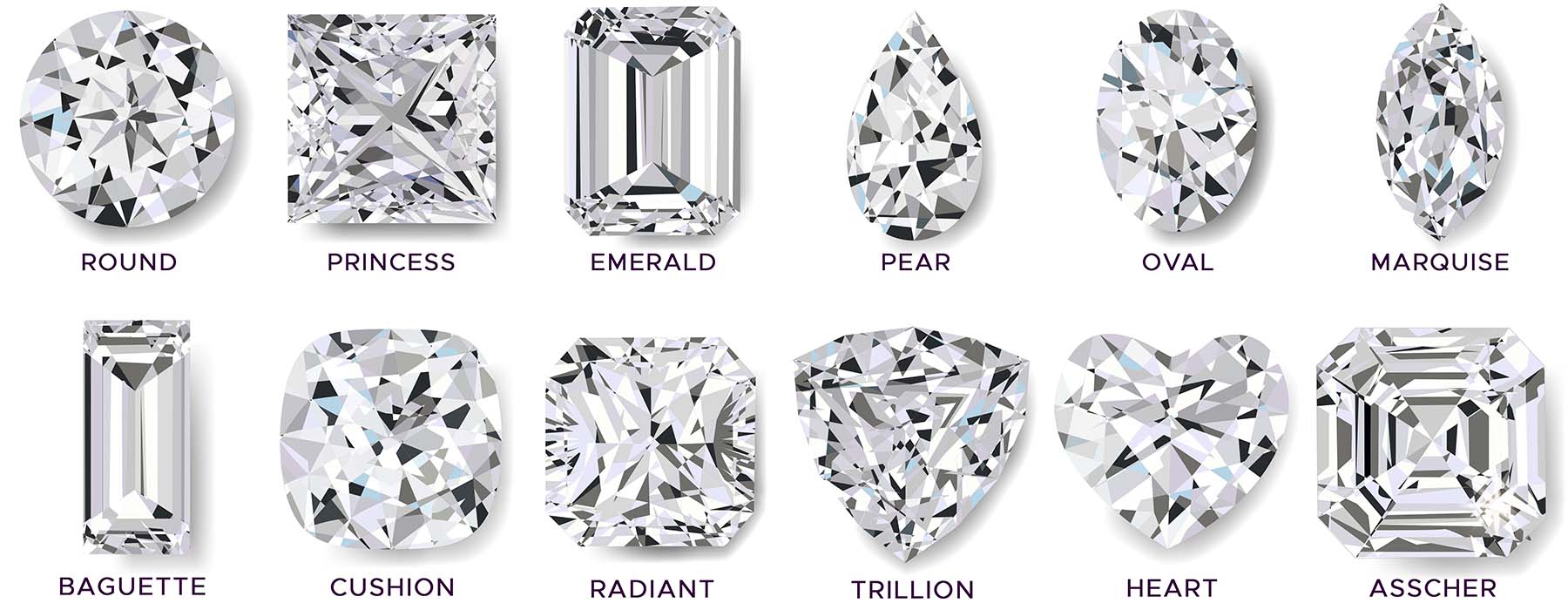all about DIAMONDS
YOUR NEED-TO-KNOW GUIDE
THE FOUR C'S EXPLAINED
What makes a diamond special? Is it the cut? Or maybe it’s the carat size? The colour and clarity? In fact, it is all of them. All four factors, known as The Four C’s, will help you to see what makes a truly dazzling diamond. Here’s a look at the criteria:
CARAT

The carat refers to the weight of a diamond. As a diamond’s weight increases, its value does also. For example, a 3-carat diamond is worth much more than three 1-carat diamonds – something to keep in mind when choosing among different ring designs. The word carat comes from a natural source: the seeds of a carob tree. Diamonds were traditionally weighed against these seeds until a more scientific and accurate method was employed. The unit of weight used for diamonds and other gemstones today is a metric carat, which is equal to 0.20 grams. Nearly 142 carat equals once ounce.
COLOUR
The colour of a diamond is a true differentiator. A truly colourless diamond is a rarity, but you will find a wide range of beautiful stones that reflect a warm white to yellow shade. The best choice here is a matter of personal preference.
Most diamonds have at least a trace of yellow or brown body colour. However, the colour palette of a diamond is richly varied; diamonds can cover the entire spectrum of colours. Naturally coloured diamonds are rare and referred to as ‘fancies’. These diamonds can come in tints such as a green, intense yellow (canary), red, blue, pink, amber and even black. Because of their rarity, fancy colours are held in very high esteem, especially when there is intense colour saturation.
Aside from certain fancies, the most valuable diamonds on the market today are completely colourless stones. In this respect, the diamond is the only gemstone whose colourlessness renders it more valuable.
There are international standards which have been established to grade the value of a diamond based upon its colour.
Here at ‘Jesper Velling’, we use the GIA (Gemological Institute of America) diamond grading system because it is the system most widely used and referred to by jewellers all over the world. On the GIA scale, diamond colour grades are indicated from colourless to yellow as D through Z. The top grade colour is called D.

CLARITY
The clarity is also important. After a diamond is cut, its unique inner beauty shines through. Every diamond is different, and tiny, natural imperfections, arise during formation – the fewer the imperfections, the higher the value. Flawless diamonds are quite rare, and clarity defines the distinctive beauty of each stone.
Abrasion – Tiny nicks along face edges, producing a fuzzy appearance instead of sharp facet edges.
Extra facet – A facet not required by the cutting style, placed without regard for symmetry.
Natural – Part of the original crystal surface remaining on a polished stone.
Nick – A tiny chip or notch near the girdle or facet edge.
Pit – A tiny opening or hole.
Scratch – Normally seen as a fine white curved or straight line.
Surface graining – Surface indication of structural irregularity. May cross facet junctions as faint lines or cause a grooved or wavy surface.
Bearding – Tiny feathers extending from a rounded girdle.
Chip – Often a small hole or shallow opening, usually on the girdle edge.
Cloud – A hazy or milky area made up of a number of very small inclusions, usually pinpoints; sometimes needles.
Feather – A separation or break due either to cleavage or fracture, often white and feathery in appearance.
‘Carbon’ Spots or Pinpoints – Specks appearing to be black are typically tiny cracks or crystals.
Internal Graining – Internal growth lines which indicate irregular crystal growth; may appear milky, like faint lines or streaks, or may be coloured or reflected.
Pinpoint – A very small inclusion which under 10x magnification, appears as a dot, either singly or in groups of strings.
The GIA clarity grading system assigns clarity ‘codes’ ranging from F to I-3. These codes are defined and described below.
F / IF – Flawless / Internally Flawless
Diamonds in this category have no internal or external imperfections. IF diamonds may have some minor surface blemishes.
These rare diamonds must be free of internal imperfections when examined by a qualified diamond grader using 10x magnification.
VVS – Very Very Slightly Included
Diamonds in this category may have a very tiny pinpoint of carbon, cloud, gas bubble, polishing line or faint knot line, faintly visible only through the pavilion and small and shallow enough to be removed by minor repolishing. These inclusions are difficult for even a skilled grader to locate under 10x magnification.
VS – Very Slightly Included
May have some inclusions that are more easily visible under a 10x magnification. A bubble or included crystal or other small blemish may be seen through the crown.
SI – Slightly Included
These diamonds contain larger inclusions that may still not be visible face up to the naked eye but visible under 10x magnification.
I – Imperfect
Refers to diamonds with inclusions that are visible to the naked eye.

CUT
The cut or shape is chosen by a skilled artisan – they use their knowledge and expertise to unlock a diamond’s potential to shine. Our craftsmen delicately design the cut that will best transform a rough diamond into a sparkling stone. There are many cuts – including round, brilliant, princess, and baguette – but what is more important are proportions, symmetry, and polish. An accurately proportioned stone will attract a higher price, as the cut of a diamond dramatically influences its fire – the rainbow flashes of light reflected from within the stone, and its brilliance – its brightness.
The term ‘cut’ is sometimes confusing because it has a variety of meanings. Generally, cut refers to:
The shape of a gemstone.
The cutting style (such as brilliant or step-cut).
The proportions of the stone (such as big or small table facet, deep or shallow pavilion).
The make is determined by the angles of the crown and pavilion facets, the size of the table and culet, and the overall symmetry of the stone.
The finish of a stone (such as polishing marks or smooth flawless surface, misshapen, or symmetrical facets).

After careful examination of the rough stone, the cutter decides on a final shape for the diamond. Their decision is influenced by several factors such as the original shape of the stone, its dimensions, inclusions and the inevitable loss of weight during cutting.
It is the cut that enables a diamond to make the best use of light. When a diamond is cut to good proportions, light is reflected from one facet to another and then dispersed through the top of the stone. If the cut of the diamond is too deep, some light escapes through the opposite side of the pavilion. If the cut is too shallow, light escapes through the pavilion before it can be reflected.



START THE PROCESS NOW
Our bespoke jewellery services are here to turn your unique ideas into stunning, one-of-a-kind pieces. Every commission begins with a no-obligation chat about your design, where we will guide you through each step of the process to ensure that your piece is perfect.
Whether you are looking to immortalize a special moment or create a timeless family heirloom, we are here to help. Location need not be a barrier; we create bespoke fine jewellery for clients all around the world!
Do not wait to bring your vision to life – GET IN TOUCH WITH US TODAY!
